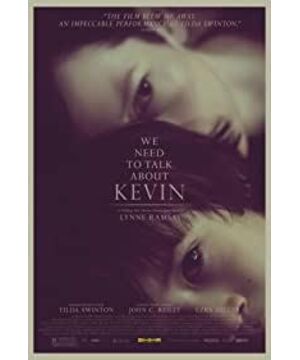Scottish director Lynne Ramsay's 2011 movie We Need to Talk about Kevin tells the story of a traveler and adventurer Eva (Tilda Swinton). Her life is completely ruined and her world collapsed after her son Kevin (Ezra Miller) conducted a massive killing of his schoolmates and his father and sister. Eva goes on a reflective journey of the past, of her irreconcilable passion and traveling and her domestic life, and of the parenting of Kevin.
In the film, sound, especially music and sound effects, is adopted as a powerful tool to present the mental and psychological state of Eva, both during her upbringing of Kevin as a toddler (Rock Duer) and as a child (Jasper Newell) and during her life after the teenager Kevin conducted the massacre. Eva was mentally traumatized after the cruel deeds of Kevin and the death of both her husband and daughter. She became very diffident of herself and loses her passion for both traveling and life. Her pessimism and A sense of insecurity were further encouraged by the abomination from citizens especially the relatives of those who died in the massacre. These information are conveyed through her everyday interactions with others in the present time and, more importantly, through the use of sound effects and music.
First of all, environmental sounds and noises are heightened to a hyper-realistic degree. In the scene when Eva woke up after her dreams of the past, she clumsily hit her toes on the foot of a tea table. The drop of pills after the hit generated such loud and abrupt sound that suddenly broke the silence, creating a chaotic and unsettling feel of emotion. The volume of sounds is indeed carefully manipulated in the film. Another example will be one of the scenes when Eva was driving. The jarring sound of windscreen wiper is emphasized to create an unpleasant feeling.
Later in the film, the scene of Eva visiting Kevin in the prison relies entirely on sound effects instead of dialogues to illustrate the interaction between the mother and the son, presenting the mother's nervous state of mind. The clear and crisp sound of nails being snapped reinforces the dramatic extreme close-ups of Kevin biting his nails. The audience is encouraged to sense Eva's hyper-attention on the action of Kevin. Not only the sound of nails being snapped is made loud on purpose, but also the sound of Eva separating her lips. Clearly, in real life, one would not hear or notice that soft and brief sound of separating lips before others speak. Nevertheless, here, emphasizing that light sound calls attention to the following silence and speechlessness, leading the audience to see and to sense how overwhelmed and helpless was Eva.
The film's second creative decision of sound using is the adoption of a great deal of patterned, repetitive, or mechanical sounds. These sounds in general form a repressive and ominous tone, which contributes to the construction and expression of the depressed and strained mental state of Eva. Towards the beginning of the film, when Eva walked out of her daubed house, there were dreadful yet loud beats. One only gets to know that this is the sound of a boy patting a basketball in front of her house after the camera shifts to frame that boy. The play of off-screen and in-screen sounds in this scene calls attention to both the dull and repressive sound itself but also the boy and his gloomy facial expression; this is the unfriendly world in Eva's eyes.
The mechanical and monotonous sounds occur again in the scene when Eva walked the infant Kevin through a construction site. There are actually many possible choices to present a construction site that would be realistic. Yet, the scene adopts the repetitive and dreadful sounds of certain machines (perhaps motors) instead of those of others, such as the penetrating sound of a power drill. On top of that, started baby Kevin's sound of crying or, to put it in Eva's words, screaming. The low pitch construction noise served as a foil to the high pitch “screams” of Kevin. Furthermore, there repetitiveness echoed each other and made each other more unbearable. In fact, the “screams” of Kevin are interestingly unvaried; unlike the baby cries used in most of other films, which change rhythm, pitch,or loudness to form a fidelity of how babies cry in real life, the sound here is made unreal on purpose. It seems to be a single cry being played over and over again. This sound is clearly an expression of the Eva's distorted perception of that world with Kevin, and the audience is allowed to peep into her collapsing mind through this subtle manipulation of sounds.
The most important repetitive and monotonous noise used in the film is certainly that sound of water sprinklers. The movie starts with the scene in Eva's house. The camera focuses on the opened door and the curtain waving in the wind. The audience is suppressed of the information beyond that curtain. One hears the “ta ta ta ta” noise coming from somewhere, but has no idea if the sound is from the world of the story, thus being diegetic, or is simply an added non-diegetic sound effect to add to the tension of that dreadfully dark and gloomy room. When the camera zooms closer to the curtain as if the eyes that the audiences see through were approaching that door, that sound becomes louder. This really creates suspense and makes one wonder if it is really something behind that curtain which makes the noise and the next frame is about to reveal it.However, at the crucial moment of bringing the answer to light, that sound suddenly shift to a much quicker pace and burst into uproariousness. This is the sound of nervous and suspense, and the audience remains uninformed of its source for most parts of the film .
That sound occurs again in the scene when Kevin painted over Eva's maps. After Eva hung up her phone, she called Kevin's name but no one responded. The sound started at the moment when her facial expression suddenly changed and her body language became stiff. She knew that something bad must have happened and the movie shows that by adding a non-diegetic sound of the water sprinkler, which the audience is familiarized at the beginning of the film. The use here indeed brings back the nervous feelings, anxiety and suspense built up in the opening scene and, thus, successfully presenting Eva's suddenly strained emotions.
The climax of the film, that massacre done by Kevin, and the revealing of it echo the opening scene. Eva went back home trying to find her husband and daughter. She heard that sound and walked towards its source and thus towards the curtain. The next shot shows dead bodies and water sprinklers which are the sound source. The audience is finally given the answer at the same time when Eva found out the death of her loved ones. Throughout the film, the sound of the sprinklers are associated with all those negative emotions and feelings, such as anxiety and sadness. It is indeed depressive yet absorbing, pulling the audience to a state of resonance with Eva.
In addition to the manipulation of sound effects' volumes and types, the film also used music as a powerful tool to convey Eva's state of mind. In many of the scenes when Eva was driving on her way, musics that do not belong to her environment are added to give the audience more information. Those musics have such bright and light melodies that even seem out of place at first glance. In fact, unlike the sound effects that conforms to the tension of the film, those musics set off that by contrast .
One example would be the scene when Eva drove home on Halloween night, with a background music of Buddy Holly's Everyday. The song is lively and fast paced, conforming to the normal and undistorted mood of Halloween. However, the facial expressions tell that Eva was frightened and her point of view reveals a distorted uncanny world where kids looked at her in cankered ways. The film is able to simultaneously present the perspectives of an ordinary eye and of Eva through juxtaposing the joyful auditory component of Everyday and the terrifying visual component of "ghosts" and "monsters." The stark contrast between the two heightens one's understanding of Eva's traumatized and unsettling mind.
We Need to Talk about Kevin is a film that effectively uses sound to present the emotions and mental states of the character, Eva. It has made very conscious choices regarding the emphasis on certain sound effects, the use of mechanical sounds of repetitive rhythms, the play of diegetic vs. don-diegetic sounds and of off-screen vs. on-screen sounds, and certain pieces of musics. Those carefully chosen and manipulated sounds either add to the mood of what is visually presented or dramatize it through contrast. In either way, the audience is encouraged to better understand the anxiety, the sadness, and the pessimism of Eva.
View more about We Need to Talk About Kevin reviews











